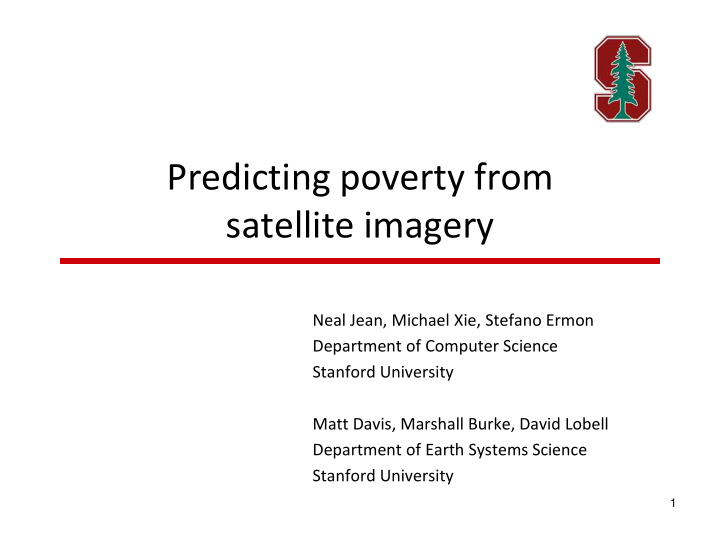



Predicting poverty from satellite imagery Neal Jean, Michael Xie, Stefano Ermon Department of Computer Science Stanford University Matt Davis, Marshall Burke, David Lobell Department of Earth Systems Science Stanford University 1
Why poverty? • #1 UN Sustainable Development Goal – Global poverty line: $1.90/person/day • Understanding poverty can lead to: – Informed policy-making – Targeted NGO and aid efforts 2
Data scarcity 3
Lack of quality data is a huge challenge • Expensive to conduct surveys: – $400,000 to $1.5 million • Data scarcity : – <0.01% of total households covered by surveys • Poor spatial and temporal resolution 4
Satellite imagery is low-cost and globally available Shipping records Agricultural yield Inventory estimates Deforestation rate Simultaneously becoming cheaper and higher resolution (DigitalGlobe, Planet Labs, Skybox, etc.) 5
What if … we could infer socioeconomic indicators from large-scale, remotely-sensed data? 6
Standard supervised learning won’t work Input Output Poverty, wealth, Model child mortality, etc. - Very little training data (few thousand data points) - Nontrivial for humans (hard to crowdsource labels) 7
Transfer learning overcomes data scarcity Transfer learning: Use knowledge gained from one task to solve a different (but related) task Train here Perform here Transfer 8
Transfer learning bridges the data gap B. Proxy outputs Plenty of data! Would this work? Deep learning model Less data needed C. Poverty measures A. Satellite images Not enough data! 9
Nighttime lights as proxy for economic development 10
Why not use nightlights directly? B. Nighttime light intensities C. Poverty measures A. Satellite images 11
Not so fast … Almost no variation below the poverty line 12
Lights aren’t useful for helping the poorest 13
Step 1: Predict nighttime light intensities B. Nighttime light intensities Deep learning training model images sampled from these locations C. Poverty measures A. Satellite images 14
Training data on the proxy task is plentiful Labeled input/output training pairs ( ) Low nightlight , intensity training … images sampled ( ) from these High nightlight , locations intensity Millions of training images 15
Images summarized as low-dimensional feature vectors Convolutional Inputs: daytime Neural Network Outputs: Nighttime satellite images (CNN) light intensities {Low, Medium, High} f 1 f 2 Night- … Light Nonlinear Linear mapping f 4096 regression 16
Feature learning f 1 f 2 Night- … Nonlinear Light Linear mapping f 4096 regression 𝜄′ 𝜄 𝑛 𝑚 𝑧 𝑗 , 𝑛 𝑚 𝑧 𝑗 , 𝜄 𝑈 𝑔(𝑦 𝑗 , 𝜄′ ) 𝜄,𝜄′ 𝑗=1 𝜄,𝜄′ 𝑗=1 min 𝑧 𝑗 = min Over 50 million parameters to fit Run gradient descent for a few days 17
Transfer Learning Feature Inputs: daytime Outputs: Nighttime Learning satellite images light intensities {Low, Medium, High} Target task f 1 f 2 Poverty … Nonlinear mapping f 4096 Have we learned to identify useful features? 18
Model learns relevant features automatically Satellite image Filter activation map Overlaid image 19
Target task: Binary poverty classification • Living Standards Measurement Study (LSMS) data in Uganda (World Bank) – Collected data on household features • Roof type, number of rooms, distance to major road, etc. – Report household consumption expenditures • Task : Predict if the majority of households in a cluster are above or below the poverty line 20
How does our model compare? Survey-based model is the gold standard for accuracy but … – Relies on expensively collected data – Is difficult to scale, not comprehensive in coverage 0.8 0.75 0.71 0.7 0.6 0.53 0.5 Accuracy 0.4 0.3 0.2 0.1 0 Survey Nightlights Transfer 21
Transfer learning model approaches survey accuracy Advantages of transfer learning approach: – Relies on inexpensive, publicly available data – Globally scalable, doesn’t require unifying disparate datasets 0.8 0.75 0.71 0.7 0.6 0.53 0.5 Accuracy 0.4 0.3 0.2 0.1 0 Survey Nightlights Transfer 22
Our model maps poverty at high resolution Smoothed predictions District aggregated Official map (2005) Case study : Uganda - Most recent poverty map over a decade old - Lack of ground truth highlights need for more data 23
We can differentiate different levels of poverty 2 continuous measures of wealth: • Consumption expenditures • Household assets We outperform recent methods based on mobile call record data Blumenstock et al. (2015) Predicting Poverty and Wealth from Mobile Phone Metadata, Science 24
Transfer Learning Feature Inputs: daytime Outputs: Nighttime Learning satellite images light intensities {Low, Medium, High} Target task f 1 Expenditures f 2 … Assets Nonlinear mapping f 4096 25
Models travels well across borders Can make predictions Models trained in one country perform well in in countries where no other countries data exists at all 26
What do we still need? • Develop models that account for spatial and temporal dependencies of poverty and health 27
Take full advantage of incredible richness of images 28
A new approach based on satellite imagery We have introduced an accurate , inexpensive , and scalable approach to predicting poverty and wealth 29
30
Recommend
More recommend